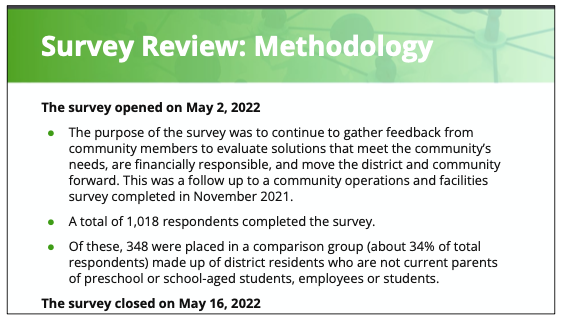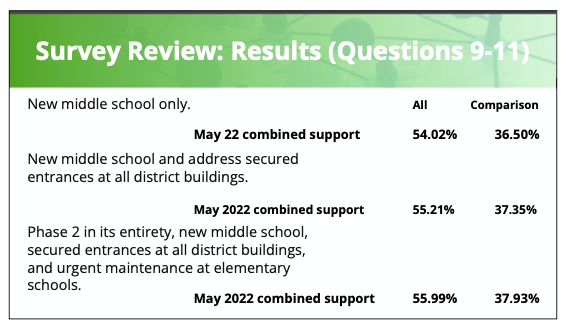By Kim McDarison
The School District of Fort Atkinson Board of Education during its Thursday meeting received survey results as presented by the Donovan Group. The organization has facilitated two surveys revolving around facility-based and operational needs of the district.
Referendum questions to address both are being considered by the board for potential placement on the November ballot.
Results presented by members of the Donovan Group Thursday were collected through a survey made available to the community in May.
Information presented, as determined by the May survey, indicates that voters within the School District of Fort Atkinson give priority to funding facility projects in the following order: urgent elementary maintenance, secured entrances at buildings, and building a new middle school.
An earlier survey was conducted by the company last November.
Addressing the board in advance of the presentation of the most recent survey’s results, School District of Fort Atkinson Superintendent Rob Abbott noted that the survey focused on the buildings within the district and their “accessibility, status and safety.”
Said Abbott: “In November of 2021, the School District of Fort Atkinson asked voters to participate in a community survey to evaluate the district’s financial and facility needs and then to consider possible solutions in order to offer their feedback. Understanding that much has changed over the past several months, in May of 2022, we again asked residents to complete a followup survey to provide additional input on how much things had changed since we had polled our public back in November.
“As in November, we continued to work with the Donovan Group to help facilitate this community engagement effort.”
Abbott next introduced two members of the Donovan Group: its founder and president Joe Donovan and Perry Hibner, whom he described as an individual who “works with public schools and districts in the Wisconsin and Illinois surveys, polling and focus groups, and analysis services as part of the Donovan Group intelligence.”
Abbott said the group “works with hundreds of schools and districts on their communications efforts and has advised state superintendents, state legislators and members of Congress around the country.”
Addressing the board, Hibner produced a series of slides, titled: “Operations and Facility Community Survey Report,” showing survey responses as collected from over 1,000 members of the district in May.
Slides presented by Hibner follow.

Introducing the first slide, shown above, Hibner said: “Districts all over the state are also engaging their communities regarding potential operational referendum questions in November and/or facility bond capital questions.
“Our survey is not a scientific sample. As such, it should be treated as qualitative data that is similar to data from a large number of focus groups.
“Because we used a convenience sample, it would be methodologically inappropriate to carry out a regression analysis or attempt to calculate error, so saying for example, plus or minus 3 or 4, on any of these questions.”
Hibner continued: “Over the years we have found our community survey results to be very indicative of what residents believe about the questions and statements provided. For example, we did community surveys for a handful of Wisconsin districts that put questions on the April 2022 ballot and the results of those questions mirrored in each district what we found in their respective surveys.”

Introducing the next slide, pictured above, Hibner noted that the survey conducted in May was kept open for two weeks, which, he said, was the same time allotted for residents to respond to the earlier November survey.
Describing the process, Hibner said a postcard was mailed to each household in the district, encouraging adults to take the survey and giving them a QR code to access the survey. The survey was also made available in hard copy form “through locations,” he said, adding: “The district did a good job of sending out emails and using social media and other communication tools to continually remind residents while the survey was open.”
Describing methodology and data as provided in slides presented Thursday, Hibner noted: “We set up three groupings. The first column … shows the percentages of all 1,018 residents who completed the survey. The second column shows the percentages for 348 residents who were part of what we call a comparison group.” A slide indictated that the group was comprised of about 34% of survey respondents.
Defining the comparison group, Hibner said the group comprised people who are not parents of preschool or school-aged students.
He added: “The comparison group does include parents of former district students, along with grandparents of current students.”
Additionally, Hibner said, “We also have added a third column, and we’ve been doing that since March.”
The new column, according to Hibner, “provides a weighted average of those who are affiliated with the district and the comparisons group. In most districts, and I don’t think Fort Atkinson is any different, about 70% of your eligible voters do not have an affiliation with the district, which is why we gave that group a .7 weight when we were doing this.
“Those who are affiliated with the district get a .30 weight. So when we look at that third column, that’s where that comes from.”

Hibner next provided a slide, shown above, addressing “Question 6” of the survey, which read: “I believe the school district’s most urgent financial needs be addressed now.”
Said Hibner: “In most cases, the percentages of respondents who ‘strongly agree’ or ‘agree’ to this statement … tends to be higher than the support for specific solutions. Makes sense, right? You ask the question generally, and then when you start talking about the solutions, sometimes people might say, ‘I want something different.’ Or once we show tax impact, which we did in November, they say, ‘I like the solution, but I can’t afford it right now.’
“This statement often sets the ceiling for support-specific solutions.”
He added: “You will note support is actually increased since November … to address the district’s most urgent financial needs.
“That is encouraging.
“As we often witness, the all-responding group, which is parent-heavy, is almost always more likely to agree or strongly agree that needs must be address now.”
He continued: “To have more than 60% support for the comparison group and 65% support in the weighted group is again encouraging for what we might be doing moving forward.”

Introducing the next slide, which shows, as displayed above, responses to survey “Question 7,” which read: “How likely are you to support an operational referendum question on the November 2022 ballot?” Hibner said nearly 64% of all respondents said they would definitely or probably support an operational referendum question in November.
“The weighted category still has nearly 56% support, which bodes well for the district if the right amount of tax impacts are determined,” Hibner said.
In his experience with other districts, he said, he has found that survey results, between the time when a survey is conducted and a question is placed on a ballot, can change.
“You know the reality is we have an opportunity to engage your community over the next few months. So hopefully those numbers will go up a bit. How much? Joe (Donovan) likes to say 5 percentage points,” he said, describing that increase as “a realistic goal to strive for.”

Pointing to a slide, shown above, displaying responses to survey Question 8, which read: “I believe the district’s facility needs must be addressed now,” Hibner, reiterating an earlier statement, said: “In most cases the percentages of respondents who strongly agree or agree to this statement tends to be higher than the support for any specific solutions we put out there. This statement sets the ceiling for support for specific solutions.”
Hibner said more than 67% of all respondents and slightly more than 50% of the comparison group believed the district’s facility needs must be addressed now.
He continued: “What I want to emphasis is that percentages for each of these groups are about 6-7 points lower than they were in the November 2021 survey.”
He cited a potential for economic turmoil nationwide and worldwide as a potential reason for the drop.
“The weighted category indicates that’s nearly 59% support this statement. I believe of our three sets of data, the weighted category is by far the most important. That gives you the best indication and snapshot of where the community is right now,” he said, adding: “The board and the district will need to determine which needs are prioritized though, based on this, I would say.”


Citing data developed in response to Question 10, which read: “I would vote ‘yes’ on a referendum question to build a new middle school and address secured entrances at all district buildings, Hibner noted that more than 55% of all respondents said they were in support of a referendum to address both needs, with more than 37% of the comparison group supporting the same option.
Additionally, he said, he believed the data represented a lot of “uncertainty” for community members, and “nervousness.”
It’s not that they disagree with the need, he said.

Sharing data collected through survey Question 11, which read: “I would vote ‘yes’ on a referendum question to address Phase 2 in its entirety, which includes building a new middle school, secured entrances at all district buildings, and urgent maintenance at elementary schools,” Hibner said nearly 56% of all respondents and nearly 38% of the comparison group indicted they would support a referendum to build a new middle school, add secured entrances at all district buildings, and address urgent maintenance at elementary schools.

Presenting a summary of date collected through survey questions 9-11, Hibner indicated that a higher percentage supported the final option, Phase 2 as a whole, than the previous two, indicating there is a portion of the community that wants to see the district address all components of Phase 2 now.

Hibner said survey Question 12, which read: “As shared throughout this survey, Phase 2 contains most urgent facility needs of the school district. If we are unable to complete the entire phase at once, please rank the Phase 2 elements in order of importance for completion with 1 being the most important, and 3 being the lease important,” was not included on the November survey. The responses indicated that completing “urgent elementary maintenance” was of the highest priority to the community, followed by “secured entrances at buildings,” and “new middle school.”
In conclusion, Hibner encouraged the board to “trust your data.”
He called the survey results “encouraging.”
“It was fantastic to see more than 1,000 residents complete the survey. It represents more than 38% of your K-12 student population,” he said.
In Wisconsin, he said, the range of community members within districts completing surveys is between 18 and 40%.
Said Hibner: “You’re on the very high percentage in terms of participation.
“It’s good data, it’s strong data, it’s accurate data.”
School District of Fort Atkinson Board of Eduction President Kory Knickrehm said he was happy to see that the numbers were “pretty consistent” throughout the survey.
A story presenting results from the survey administered by the district last November is here: https://fortatkinsononline.com/school-survey-data-released-75-of-respondents-say-district-should-address-needs-now/.
This post has already been read 1766 times!